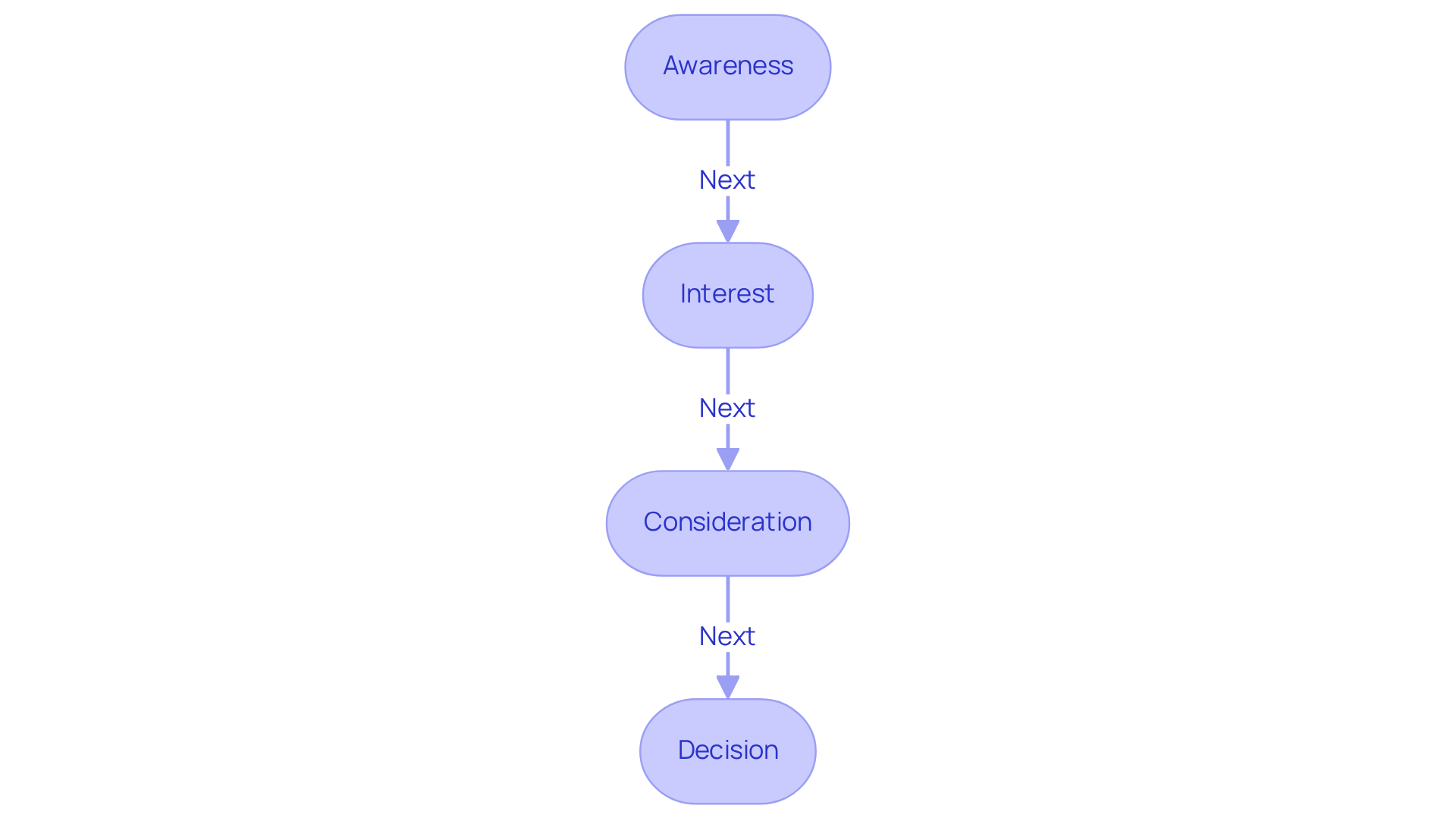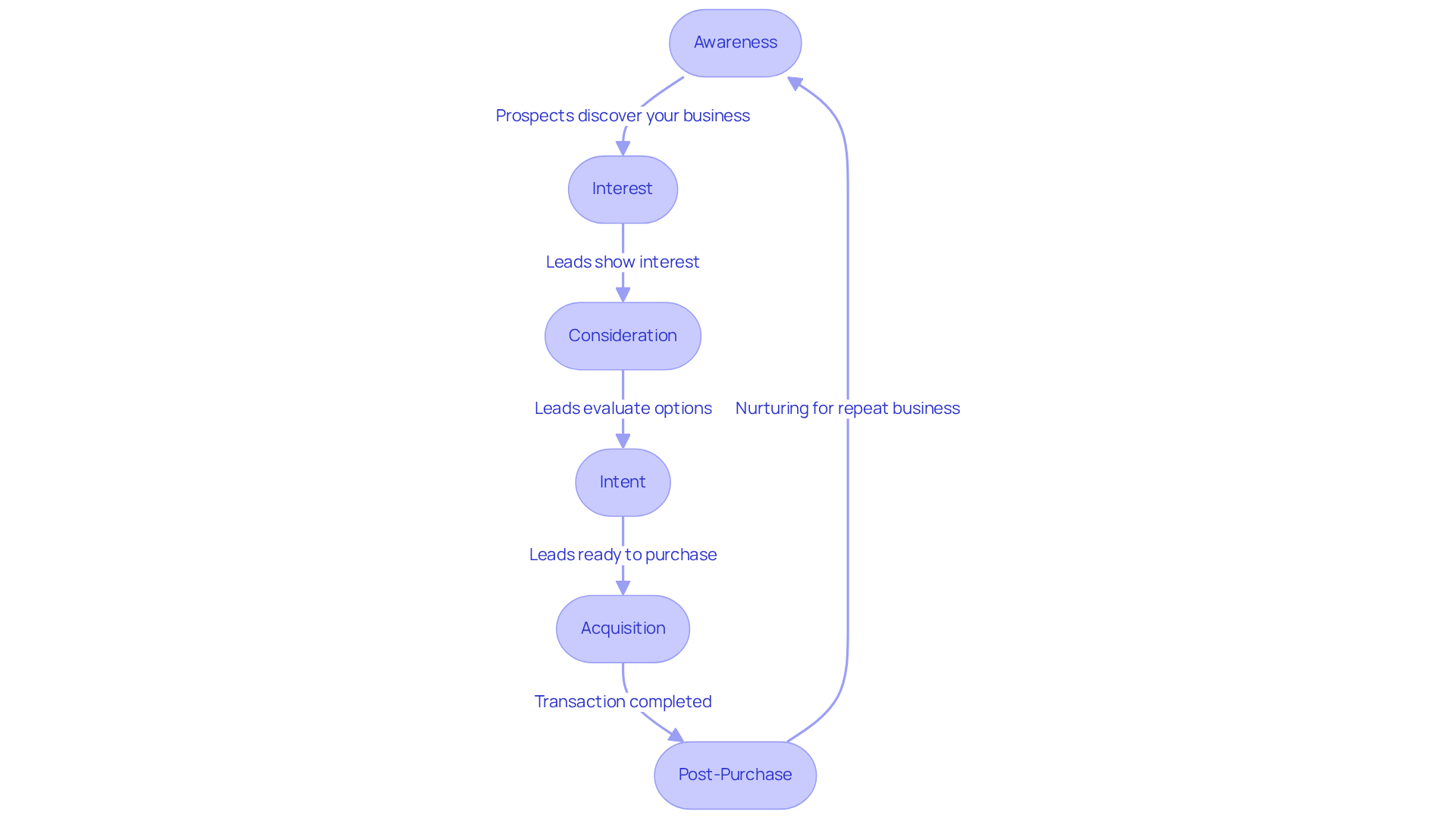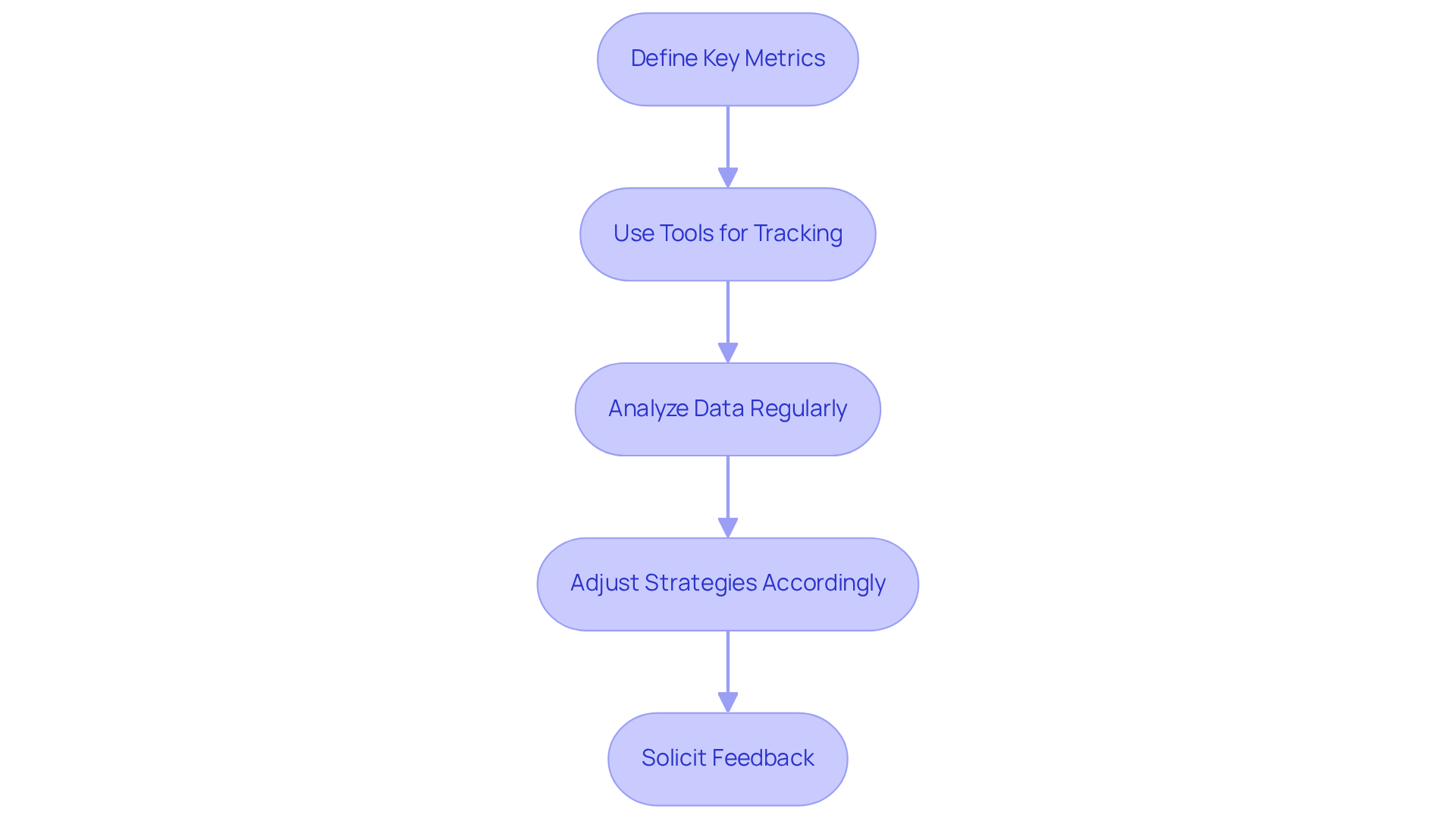Overview
This article highlights the essential steps that small businesses can take to master their lead pipeline, paving the way for success. By outlining the stages of the sales funnel—from Awareness to Post-Purchase—it emphasizes the importance of monitoring key metrics. This structured approach not only helps businesses effectively manage their sales processes but also significantly improves conversion rates. We understand your challenges, and together we can achieve success by applying these insights.
Introduction
Navigating the complexities of a lead pipeline can truly make a difference in your small business journey, steering you toward success rather than stagnation. This vital process not only tracks potential clients from their initial interest to becoming loyal customers but also empowers you to refine your sales strategies effectively.
We understand that many small business owners grapple with how to structure and optimize their lead pipeline. What key stages must you identify, and how can you analyze metrics to ensure continuous improvement?
Together, we will unpack the essential steps to master your lead pipeline, unlocking the potential for sustainable growth and enhanced customer relationships.
Define Your Lead Pipeline: Understanding the Basics
A sales funnel is a visual representation of the journey prospective clients take before making a purchase. Understanding this journey is essential for , and we’re here to support you through it.
Understand the concept: Think of your lead pipeline as a method to track potential clients from their initial spark of interest in your product or service to their development into loyal customers. This process is vital for the success of small businesses, as it helps you manage your sales efforts in a systematic way.
- Identify Your Audience: Who are your ideal clients? Knowing this allows you to tailor your outreach efforts effectively, ensuring your messaging resonates with those who matter most. This understanding fosters a deeper connection with your audience.
- Outline the Phases: Break down the customer journey into phases like Awareness, Interest, Consideration, and Decision. Each phase represents a different level of engagement with your business. By mapping this out, you can better plan your strategies to meet your clients where they are.
- Visualize the Pipeline: Create a simple diagram or flowchart to illustrate these phases. This visualization acts as a reference point as you develop your outreach strategies, making it easier to track your progress and stay focused on your goals.
- Set Goals for Each Stage: What does success look like at each phase? For instance, consider setting targets for how many potential customers you aim to transition from Awareness to Interest each month. This goal-setting is crucial for maintaining momentum in your sales efforts.
By clearly outlining your sales funnel, you establish an organized approach to managing your sales processes. This not only simplifies the identification of areas for improvement but also empowers you to refine your strategies for better results. Remember, together we can achieve success in your business journey.

Identify Key Stages of Your Lead Pipeline
To effectively oversee your lead pipeline, it’s important to recognize and outline the key phases that prospects will navigate. Let’s explore these stages together:
- Awareness: This initial phase occurs when potential customers first discover your business, often through social media, advertisements, or referrals. It's worth noting that 77% of shoppers prefer brands they follow online, underscoring the significance of a robust online presence for small businesses. By utilizing Wayy.ai's daily email updates, you can keep track of how many prospects are contacted at this point.
- Interest: At this stage, leads show interest in your offerings. They might visit your website, subscribe to your newsletter, or engage with your social media content. Engaging content can greatly enhance interest; in fact, 52% of B2B buyers are more likely to make a purchase after interacting with a brand's content. Wayy.ai can provide valuable insights into which content resonates most with your audience.
- Consideration: Leads are actively evaluating your product or service against competitors. They may request additional information or compare features. This phase is crucial, as effective communication can significantly influence their decision-making process. Wayy.ai can assist in monitoring engagement metrics to identify which features are most appealing to potential customers.
- Intent: This phase indicates a readiness to purchase. Leads might add items to their cart or request a demo. Understanding this intent can help tailor your follow-up strategies, as timely engagement can boost conversion rates. Wayy.ai's tracking can alert you to prospects demonstrating high intent, enabling you to follow up promptly.
- Acquisition: This final phase is where the lead becomes a buyer by completing a transaction. Ensuring a seamless transaction process is vital for client satisfaction and retention. Wayy.ai can provide metrics on conversion rates to evaluate the effectiveness of your sales process.
- Post-Purchase: This often-overlooked stage is essential for nurturing relationships, encouraging repeat business, and generating referrals. Engaging clients after a purchase can significantly enhance lifetime value (CLV), which is crucial for long-term business success. Wayy.ai can help track customer engagement and satisfaction after the purchase.
By clearly recognizing these phases in the lead pipeline, you can tailor your outreach tactics to engage prospects at their specific moments in the journey, thereby increasing the chances of conversion. Regularly monitoring conversion rates at each stage can help identify bottlenecks and optimize your lead pipeline for improved performance. Furthermore, consider using platforms like Wayy.ai, which offers daily email updates with essential metrics on contacts reached, interest shown, and conversion rates, to enhance effectively.

Monitor and Analyze Pipeline Metrics for Continuous Improvement
To ensure your lead pipeline is effective, it's vital to regularly monitor and analyze key metrics. Let's explore how you can do this effectively:
- Define Key Metrics: Start by identifying the metrics that matter most to your business. Commonly tracked metrics include conversion rates, average time spent in each stage, and source effectiveness. For instance, a typical conversion rate might hover around 25%, indicating the percentage of prospects who successfully move through the process. Additionally, knowing your average deal size is essential for resource allocation and future planning. Remember, for every dollar of your sales target, aim to have three to four dollars' worth of opportunities in the pipeline to maintain a healthy coverage ratio.
- Use Tools for Tracking: Embrace CRM software or analytics platforms to automate the tracking of these metrics. Tools like Wayy.ai can simplify this process by offering daily updates on outreach efforts, allowing you to focus on strategic adjustments instead of manual data entry.
- Analyze Data Regularly: Establish a routine for reviewing your metrics, whether on a weekly or monthly basis. Look for patterns that reveal where prospects may be dropping off or where conversions are particularly strong. Understanding these trends is crucial for optimizing your sales process. You can calculate the by dividing the number of deals won by the total number of opportunities and multiplying by 100, which helps gauge your effectiveness.
- Adjust Strategies Accordingly: Use your analysis to refine your outreach strategies. If you notice a significant drop-off rate in the Consideration stage, consider enhancing your follow-up communications or providing additional resources to nurture those prospects.
- Solicit Feedback: Regularly seek feedback from customers and leads to gain insights into their experiences. This information can highlight areas for improvement in your process and help tailor your approach to better meet their needs.
As Batu Apaydin, a marketing leader in B2B SaaS, wisely notes, "Monitoring sales metrics is essential for any business that aims to increase revenue and enhance its sales performance." By continuously monitoring and analyzing your lead pipeline metrics, you can refine your sales strategies to ensure effective engagement with leads and maximize conversion opportunities.

Conclusion
Mastering a lead pipeline is not merely about boosting sales; it's a thoughtful strategy that empowers small businesses to navigate the intricate journey from initial interest to becoming a loyal customer. By understanding and defining the lead pipeline, businesses can systematically manage their sales efforts, ensuring that each potential client is nurtured through every stage of their journey.
Key insights shared throughout this article highlight the importance of:
- Clearly identifying target audiences
- Outlining the distinct phases of the customer journey
- Setting measurable goals for each stage
By understanding metrics and employing tools for tracking, businesses can further enhance the effectiveness of their lead pipeline, refining strategies based on real-time data and feedback. Each phase, from Awareness to Post-Purchase, plays a vital role in shaping a customer’s experience and ultimately influencing their decision to engage with a brand.
The significance of a well-structured lead pipeline cannot be overstated. It not only streamlines the sales process but also nurtures lasting relationships with customers, paving the way for repeat business and referrals. We encourage small businesses to take action by implementing these strategies, leveraging tools like Wayy.ai for tracking and analysis, and continuously refining their approach. By doing so, together we can ensure sustainable growth and success in an ever-competitive market, ultimately transforming leads into loyal advocates for their brand.
Frequently Asked Questions
What is a sales funnel?
A sales funnel is a visual representation of the journey prospective clients take before making a purchase. It tracks potential clients from their initial interest in a product or service to their development into loyal customers.
Why is understanding the lead pipeline important for small businesses?
Understanding the lead pipeline is vital for small businesses as it helps manage sales efforts systematically, ensuring a structured approach to nurturing leads and converting them into customers.
How can I identify my ideal clients?
You can identify your ideal clients by understanding who they are and tailoring your outreach efforts to ensure your messaging resonates with them, fostering a deeper connection.
What are the phases of the customer journey in a lead pipeline?
The phases of the customer journey typically include Awareness, Interest, Consideration, and Decision. Each phase represents a different level of engagement with your business.
How can I visualize my lead pipeline?
You can visualize your lead pipeline by creating a simple diagram or flowchart that illustrates the different phases. This serves as a reference point for developing outreach strategies and tracking progress.
Why is goal-setting important for each stage of the sales funnel?
Goal-setting is crucial for each stage of the sales funnel as it defines what success looks like at each phase, helping maintain momentum in sales efforts and guiding strategies to transition potential customers through the funnel.
How does outlining the sales funnel help in managing sales processes?
Outlining the sales funnel establishes an organized approach to managing sales processes, simplifies the identification of areas for improvement, and empowers businesses to refine their strategies for better results.




